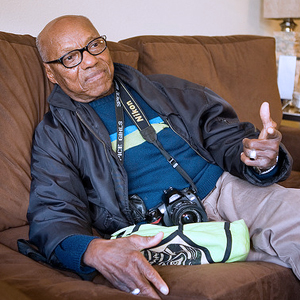
 |
|
| David Johnson |
When David Johnson returned to Jacksonville, Florida in 1946 from the U.S. Navy, he was certain of one thing, and that was that he wanted to become a photographer. What was uncertain was where he would find the opportunity to study photography. One day at his old job as a sheet metal worker, he happened to read an article in Popular Photography that Ansel Adams was starting photography classes at the CSFA. Johnson wrote to Mr. Adams seeking a spot in the first class. He mentioned that he was a Negro. Johnson received a telegram back from Adams saying the class was filled, and that it did not matter that he was a Negro, but that his name would be placed on the list in the event someone cancelled. Within a week he got another message saying there was a place in the class.
Johnson arrived in San Francisco in 1946 shortly after his 19th birthday and was met by Minor White at the Ferry Building. They took the streetcar together to the house of Ansel Adams overlooking the entrance of the San Francisco Bay. Johnson stayed there until he found a place to live in the Fillmore District–the black section of the city and a place that would shape his future. Johnson became the first African American student in the photography class at the CSFA–he'd never sat in a class with white students. He didn't realize then that the cultural and racial life of his past would drive much of his photographic career. All he needed was a tool to express what was inside. As one of his mentors, Life Magazine photographer Gordon Parks, said, "It's a choice of weapons." In many ways, the camera has changed the world through non-verbal communication. Johnson chose to focus his work on the socially relevant issues facing urban communities, especially African Americans. After WWII, the Japanese were returning to the Western Addition, commonly referred to as The Fillmore District. The Blacks found themselves in the situation of not being able to legally locate outside the Fillmore District or Hunter's Point District (where the black population located during the years when they came to the Bay Area from the southern States to work in the war-related industries). Johnson has photographed San Francisco social groups, politicians, musicians and other artists, visiting African dignitaries, and student and religious leaders. During the Civil Rights Movement of the 1950s and 1960s, he captured historic images of demonstrations and Civil Rights leaders, local and national. His photos have been on the cover of Black Scholar magazine and featured predominantly in the book Harlem of the West by Elizabeth Pepin and Lewis Watts, which documents African-American life and culture in San Francisco.
Achievements of Johnson's career include a Public Service Award from the University of California for work in the Haight Ashbury Community and Affirmative Action for Women and Minorities; photo retrospectives Lifestyles of African Americans in San Francisco in the 40's, 50's; 60's; To Tell a Story…through Griot Eyes; A Black Man in America; PBS' KQED documentary The Fillmore; KQED Television's Common Ground: Reflections of Rabbit in the Moon and The Eye of the Lens: Bay Area Black Photographers' Exhibit.